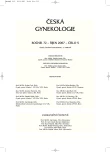-
Medical journals
- Career
Current Condition of Diagnosis and Therapy of Overactive Urinary Bladder in Czech Republic
Authors: J. Krhut 1; M. Gärtner 2
Authors‘ workplace: Urologické oddělení FN Ostrava - Poruba 1; Gynekologicko-porodnická klinika FN Ostrava-Poruba 2
Published in: Ceska Gynekol 2007; 72(5): 360-365
Category: Original Article
Overview
Introduction:
The concept of overactive bladder (OAB), indicates complex symptoms of urgency, with or without urgent incontinence and it is generally accompained by urinary frequency and nocturia. Overactive urinary bladder belongs to one of the most common health problem in our population with significant impact on quality of life. The aim of this study is to assess this problem simultaneously between gynecologists and urologists in Czech Republic, by forwarding questionnaire.Material and methods:
There were 290 respondants who answered this assessment. Out of this total number, 181 were gynecologists, and 109 urologists. Of this total number, 104 gynecologists (57.5%) work in out-patient clinic, 21 of them (11.6%) in hospital, and 56 (30.9%) in both this departments. 31 of urologists (28.4%) work in out-patient clinic, 15 of them (13.8%) in hospital, and 63 (57.8%) in both this departments.
Inquiry and questions included in questionnaire were espescially aimed at definition, diagnosis, and therapy of OAB. Results were worked by method of descriptive statistics, used instrumental method was anonym.Results:
Respondant gynecologists in the course of a week meet approx. 5.54 patients who suffering OAB, and respondant urologists meet in a week approx. 12.46 patients who suffering OAB. Correct definition of OAB mentioned only by 9 respondants (3.1%). At any rate, 57 respondants (19.6%) mentioned the basic symptoms i.e. urgency, urinary frequency, and urgent incontinence in their answer. Most common parameters employed for diagnosis of OAB including pt. history (280 respond. 96.5%), urine examination (255/87.5%), local urogynecological examination (247/85.2%), urodynamic investigation (183/63.1%), validated questionnaire (174/60%), voiding diary (139/47.9%), uroflowmetry (138/47.6%), and cystoscopy (134/46.2%). Most frequent therapeutic option is anticholinergic, followed by urinary bladder training, and application of local estrogen.Conclusion:
Common knowledge about OAB problem is still low among experts and specialists. Diagnostic and therapeutic approach of OAB is significantly different between gynecology and urology. It is somehow advisable to have many centers in where the problem of OAB can be completely engaged and solved.Key words:
overactive bladder, descriptive statistics, diagnostic, therapy, pharmacotherapy
Labels
Paediatric gynaecology Gynaecology and obstetrics Reproduction medicine
Article was published inCzech Gynaecology

2007 Issue 5-
All articles in this issue
- Inherited Metabolic Disorders and Pregnancy
- Sperm Banking before Gonadotoxic Treatment – 11-years Experience
- Lycopene Therapy in Male Infertility
- Socioeconomic Datas, the Course of Pregnancy and Delivery in Opioid-addicted Women and Women under Substitution Therapy
- Prediction of Preeclampsia Using the Integrated Test Markers
- Determination Concentrations of Tissue Factor Pathway Inhibitor and their Changes during Estrogen Replacement Therapy
- Progression and Regression Low Grade Intraepitelial Squamous Lesions in Context of Positivity of High Risk Human Papillomavirus
- Basal-like Carcinoma of the Breast – the Actual Review and Clinico-Pathological Corelations
- Da Vinci Robotic Surgery in Gynaecological Oncology: a Critical Interim Appraisal
- Current Condition of Diagnosis and Therapy of Overactive Urinary Bladder in Czech Republic
- Czech Gynaecology
- Journal archive
- Current issue
- Online only
- About the journal
Most read in this issue- Inherited Metabolic Disorders and Pregnancy
- Basal-like Carcinoma of the Breast – the Actual Review and Clinico-Pathological Corelations
- Da Vinci Robotic Surgery in Gynaecological Oncology: a Critical Interim Appraisal
- Progression and Regression Low Grade Intraepitelial Squamous Lesions in Context of Positivity of High Risk Human Papillomavirus
Login#ADS_BOTTOM_SCRIPTS#Forgotten passwordEnter the email address that you registered with. We will send you instructions on how to set a new password.
- Career

